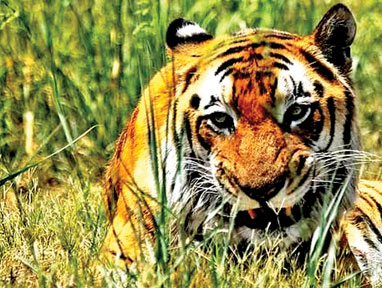Indian tigers face extinction
Scientists say the current population has just seven percent of the
total DNA that existed within the community during British Raj India's
population of tigers, which once surpassed 100,000 animals, is facing
extinction because of a collapse in the variety of mating partners,
according to new research.
Scientists say the current number of tigers has just seven per cent
of the total DNA that existed within the community at the time of the
British empire, when the animals were routinely hunted by British
officials and Indian royalty.
 The experts say that while India's dwindling numbers of tigers may
have stabilised in recent years, the threat of inbreeding is being
overlooked and that action must be taken to prevent "islands" of just a
handful of tigers that are not connected to other populations. The experts say that while India's dwindling numbers of tigers may
have stabilised in recent years, the threat of inbreeding is being
overlooked and that action must be taken to prevent "islands" of just a
handful of tigers that are not connected to other populations.
"A lot of the diversity has gone because the number has collapsed as
a result of the threat to habitat," said Professor Mike Buford of the
School of Biosciences at Britain's Cardiff University.
"What genetic diversity is left only exists in pockets. The Indian
government is saying things are reasonably all right because the
population has stabilised. But we are saying that is only part of the
story."
At the turn of the 20th Century, India was home to an estimated
100,000 of the animals. As a result of hunting, illegal poaching and
declining habitats, that number now stands at fewer than 2,000.
Scientists from Britain, in collaboration with National Centre for
Biological Sciences in Bangalore, were able to compare genetic data from
modern tigers with that of animals shot during the time of the British
Raj.
Those animals are part of the London Natural History Museum tiger
collection. The researchers found a high number of DNA variants in the
tigers shot more than a 100 years ago and that up to 93 per cent of the
that diversity missing in today's creatures.
"We found that genetic diversity has been lost dramatically compared
to the Raj tigers and what diversity remains has become much more
subdivided into the small numbers that exist today," said Bruford.
He said: "This is important because tigers, like all other species,
need genetic diversity to survive - especially under climate change - so
what diversity remains needs to be managed properly so that the Indian
tiger does not become inbred, and retains its capacity to adapt."
The latest census of tigers in India, carried out in 2011, suggested
the total number may stand at around 1,700, a figure that would
represent a stabilisation or even a slight increase on previous counts.
However, not all experts trust that figure, pointing out that the
survey was done using camera traps and extrapolation rather than pug
mark counts, as has been previously used.
Valmik Thapar, a leading Indian tiger expert, said he believed the
biggest challenge to the nation's big cats was a lack of political
leadership and poor governance.
He said the idea of the establishment of "corridors" for the tigers
that joined up various populations, would never happen.
"We don't have the political will or the governance," he told The
Independent.
The Cardiff scientists, whose work is published in the Proceedings of
The Royal Society B journal, said the territory occupied by the tiger
has declined more than 50 percent during the past three generations and
that today mating only occurs in 7 percent of its historical territory.
India accounts for perhaps 60 percent of the world's tigers. Yet
everywhere they are under threat and over the past century total numbers
have fallen by 95 percent.
Of the nine sub-species of tiger, three - the Caspian, Javanese and
Balinese - are already lost.
A fourth, the South China tiger, is considered "functionally extinct"
with perhaps fewer than 30 surviving in the wild, and the the Sumatran
tiger is listed as critically endangered.
The others - the Indochinese, the Malayan, the Siberian and India's
Bengal tiger, are all facing hue threats.
"Both conservationists and the Indian Government must appreciate that
the number of tigers alone is not enough to ensure the species'
survival," said Bruford.
"They need to protect the whole spread of forest reserves because
many reserves now have their own unique gene combinations, which might
be useful for future breeding programs."
- The Independent |


